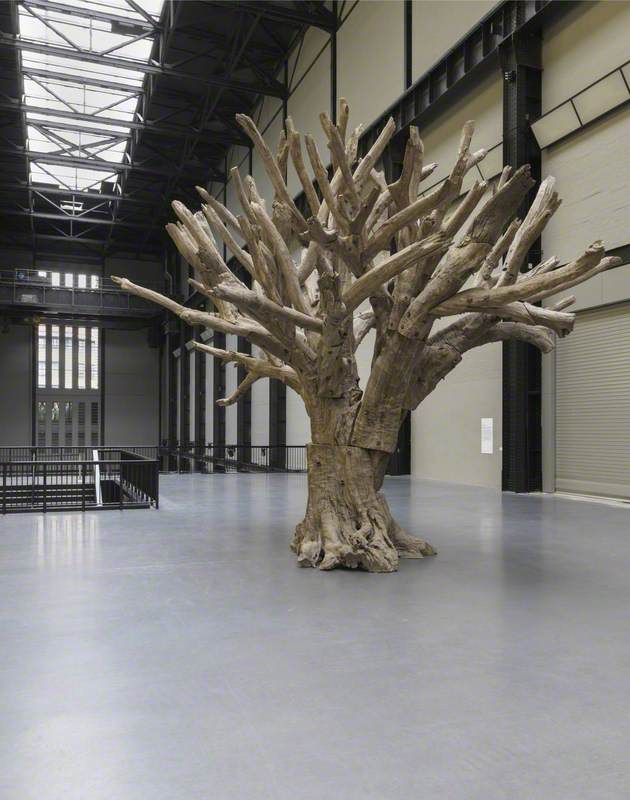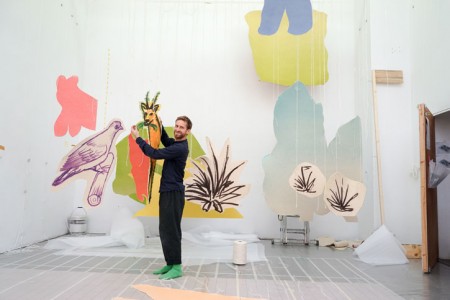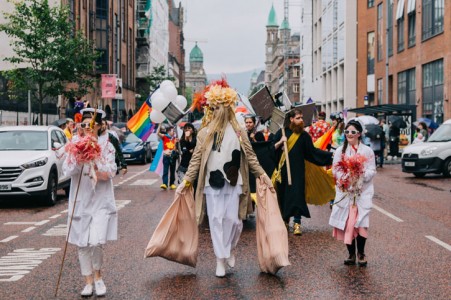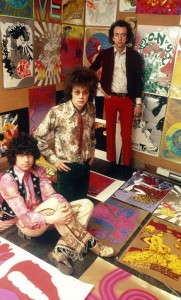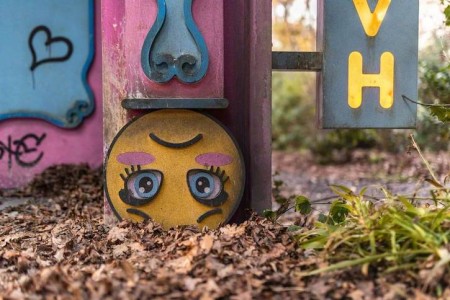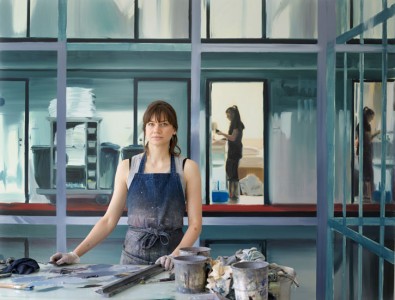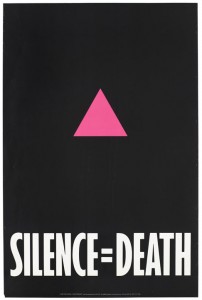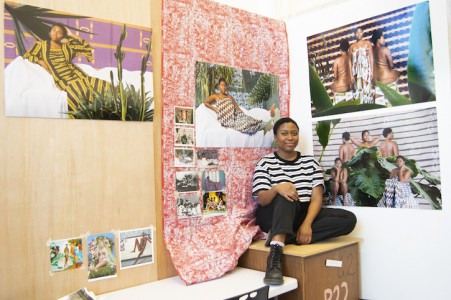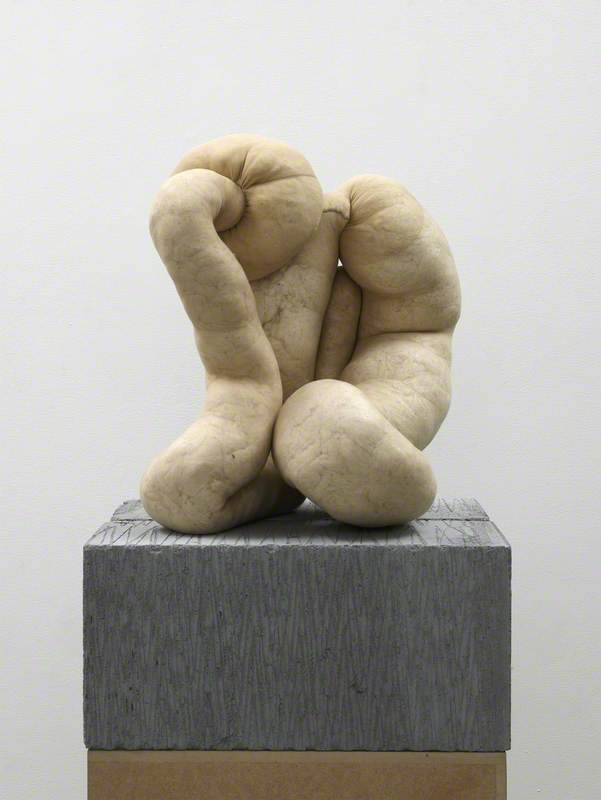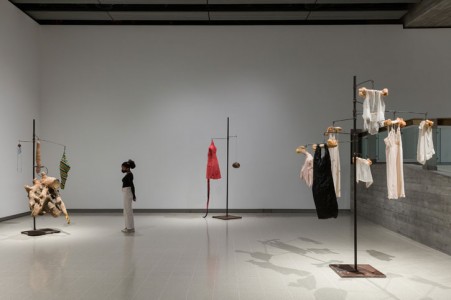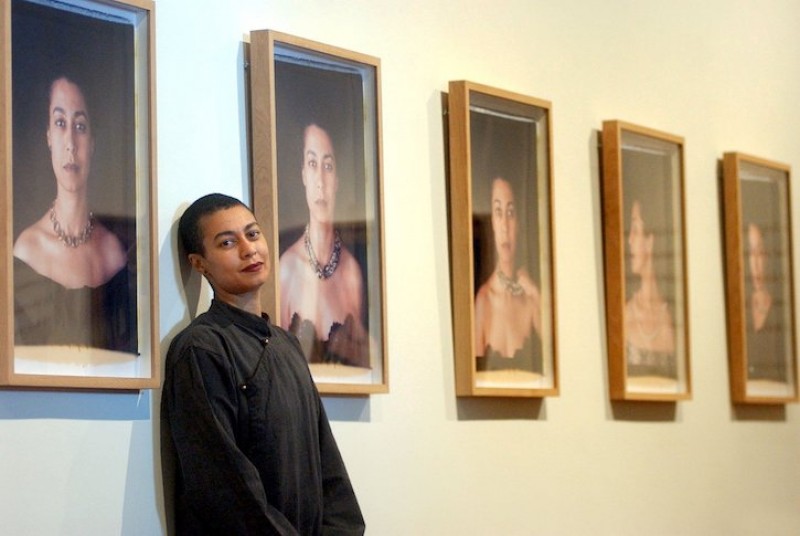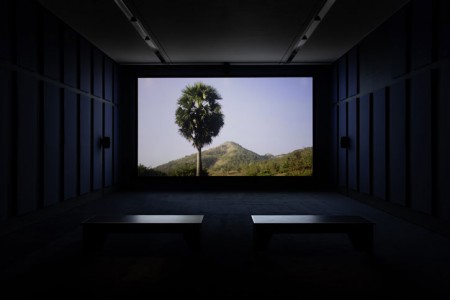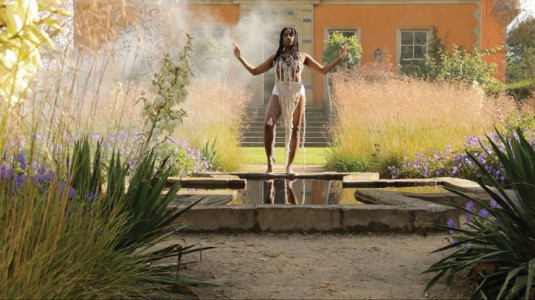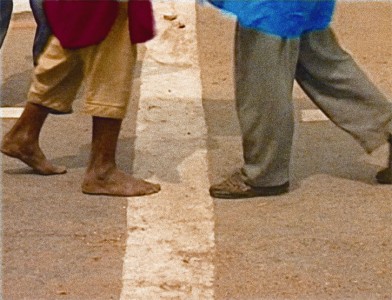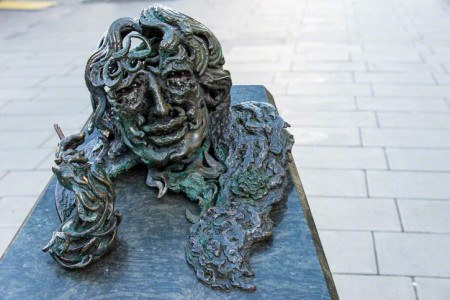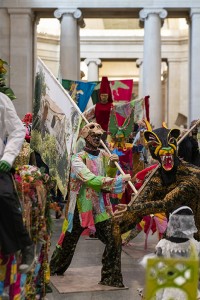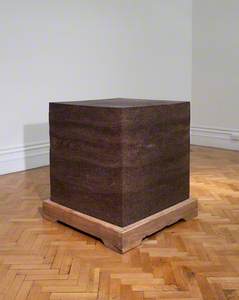From 1981 to 1993, while living in New York, Ai Weiwei was avidly devouring 'Western' art and culture as an observer in the background, who at that time was unknown apart from in small circles of the intellectual cultural milieu in China.
Ai Weiwei in his Berlin studio
It is possible to see the conscious development of his artistic persona in the fascinating set of photographs he produced in these years that give a window onto his life, interests and approach preceding his now saturated presence in the global media. In these photographs, he captures his view of daily life in New York, snapping political protests, street life, and himself posing with a large Warhol and a Duchamp in MOMA, with Allan Ginsberg in his apartment, mingling with Chinese artists, poets, filmmakers, and writers. Through these images, later published and exhibited, he constructed a consistent self-image using a rigorous methodology of documentation that characterises his work ethic and performative strategy, forged long before he rose to become a ubiquitous presence on the global art scene.
Allen Ginsberg and Ai Weiwei in New York, 1988 pic.twitter.com/2e5AdJRm5X
— Alfons López Tena (@alfonslopeztena) October 31, 2021
His more recent public visibility in the West in the past ten years has caused both ongoing admiration and contemptuous loathing by readers and viewers of his work and persona that are often difficult to untangle. Ai Weiwei's remarkable cultural status should be understood as symptomatic of the skewed, often ignorant relationship between the West and China, where both of these problematic entities obliterate the complexities and specificities of multiple layers and identities within them.
Arguably, the liberal West's desire for a voice from China answering to humanistic individualist aspirations is embodied in the persona of Ai Weiwei. On the most reductive end of this scenario, his voice can be seen to be used to echo a simplistic conflation of the quest for 'liberty' that is propagated by the liberal and now libertarian 'West'.
Yet, the clarity of his voice is compelling due to the confidence of his assertion for the right of individual human agency. Morality, a tricky subject in an era of the post-postmodern, grounds his work in an impressive contemporary call to arms.
Beijing National Stadium
2003–2008, Herzog & de Meuron and Ai Weiwei (b.1959) 
Ai gained world fame during the lead-up to the Beijing Olympics in 2008, having been part of the Herzog & de Meuron design team for the Bird's Nest Stadium, one of the head-line 'starchitect' buildings of the capital exemplifying China's new status in the world.
During this moment of China's spectacular arrival on the global stage, the world's press swarmed in, and Ai was interviewed in his studio-home in Caochangdi most days for hours on end by journalists from all over the world, as the singular 'voice of dissent' critiquing the 'fake smile' of the PRC's Olympic propaganda campaign with its 'One World One Dream' slogan.
This fake smile was personified in the performance of Lin Miaoke, the little girl who was ordered to lip-synch the words of the opening song 'Ode to the Motherland' as her face was deemed prettier than the real singer Yang Peiyi and therefore a better fit for the positive image of the event.
'Fake' read as 'fā-kē' in pinyin reads as a transliteration of the English word 'fuck' and these language puns, hugely enjoyed in China, are part of Ai Weiwei's identity as a contemporary figure within Beijing's intellectual circles that fail to translate to broader Western audiences often requiring specialist inside knowledge. Ai's engagement with the absurdity of cultural misreadings and slippages is integral to his attitude and positioning as a satirist on a quest to uncover falsities and hypocrisy.
His home, from which he is now exiled, was a self-designed house and studio that formed a strong social hub in Beijing, named FAKE on its green door, hosting numerous visits by artists, friends, journalists, curators, filmmakers, musicians. This was Ai's world for a few years of stability, before he started being harassed and finally detained by the authorities in 2011, due to his investigation into the catastrophic event of the 2008 Sichuan earthquake that led to 87,000 deaths, many of which were caused by poor building practices overseen by the State. Dubbed the 'doufu' (tofu) buildings, the tragedy caused national outrage and outpourings of criticism by the public.
Name Wall (names of children who died in the 2008 earthquake)
2008, installation by Ai Weiwei (b.1959) 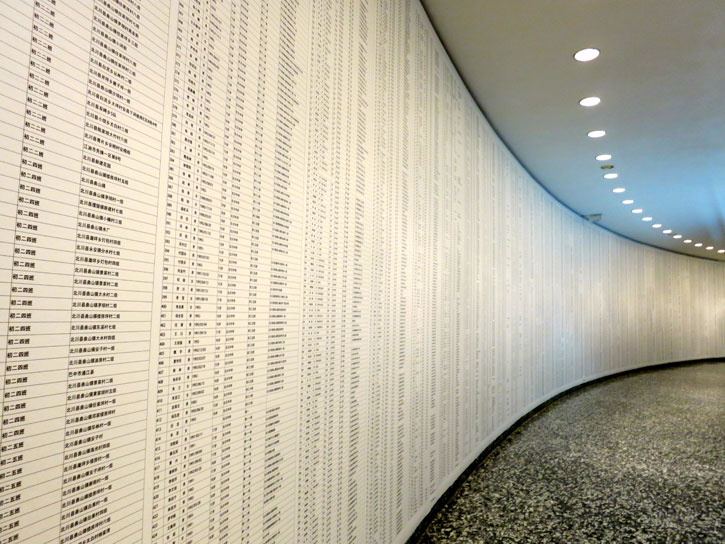
Ai's response was part of a national discourse, but his agency and persistence in documenting all the schoolchildren who died, placed him in danger for showing up the negligence of the régime. Nian (Remembrance), his work produced from this period, is a monumental sound piece, consisting of multiple voices vocally contributing the name of each of the 5,219 children whose lives were lost. This caring activation of the memory of each child throws into relief the callous disregard for life under the Chinese Communist Party and asserts his belief in and quest for humanity.
For years before his fame and detention, Ai had been active as an artist, curator, architect, documentary filmmaker and cultural commentator, having started on the fringes of Beijing's cultural world as a member of the Stars group who were active in the late 1970s and early 1980s, one of the groups known for their political activism at the end of the Cultural Revolution, calling for freedom of artistic expression. Works from the 1980s while in New York show his interest in both satire and conceptualism such as his work Safe Sex (1986), a raincoat with in-built condom produced at the beginning of the AIDS crisis and Profile of Duchamp, Sunflower Seeds (1983).
In the 1990s, Ai started scouring Beijing's newly revived antique markets and his interest in cultural heritage and historical objects grew to become an integral part of his practice. This was a decade when fakes proliferated on the market for antiquities but also the rapid rise of pirating Western goods such as DVDs circulating on the black market. The steep rise in China's economy during that decade led to exponential urbanisation causing huge swathes of the city to be destroyed, along with much of its classical heritage, including temples and traditional buildings built using craftsmanship passed down through the centuries.
Dragon Vase
2017, sculpture by Ai Weiwei (b.1959) 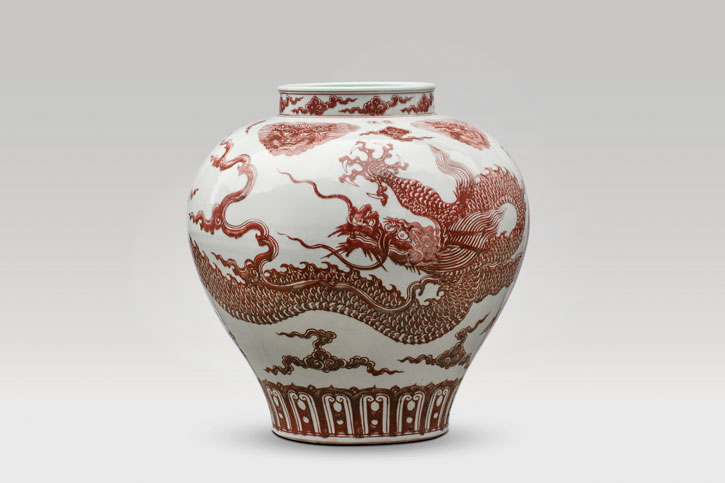
The objects that Ai brought into his practice: porcelain shards, temple wood, neolithic and Han vases, are aligned with a trajectory of Chinese history, its destruction and 'renewal' that is a well-honed story in the upheavals of the twentieth century and beyond. Placing these objects in installations and, in transforming instruments of the state such as the surveillance camera into marble, Ai highlights cultural value systems, revealing the shifting hierarchy of objects under systems of power and abuse. His interest in questioning the notion of authenticity is part of this exploration, as a key thread of Chinese cultural practice lies in copying, tracing and transmission in obeisance to the authority of past masters.
Even nature is recast and reused by Ai as a cultural artefact of sorts. His tree sculptures are composed of giant, ancient trees cast into iron and re-presented as magnificent, noble objects that have been deracinated and relocated. Other sculptures are made up of dead branches, roots and trunks from different tree species such as gingko, cedar and camphor joined together awkwardly to form a clumsy unnatural 'tree' as a possible metaphor for culture and globalisation.
In memorialising the object, he renders it as reverent (a practice embedded in Western art); in smashing it, he alludes to the impermanence of culture and its fragility. His tree sculptures are both fragmented, rejoined and recast in an artful use of natural material that is simultaneously artificial and real.
Ai can be seen as both a classical modernist and a cultural materialist, whose interest in culture as material is core to his practice. His work uses the object to tell stories of human existence and its vicissitudes.
Sunflower Seeds in the Turbine Hall, Tate Modern
2010, installation by Ai Weiwei (b.1959) 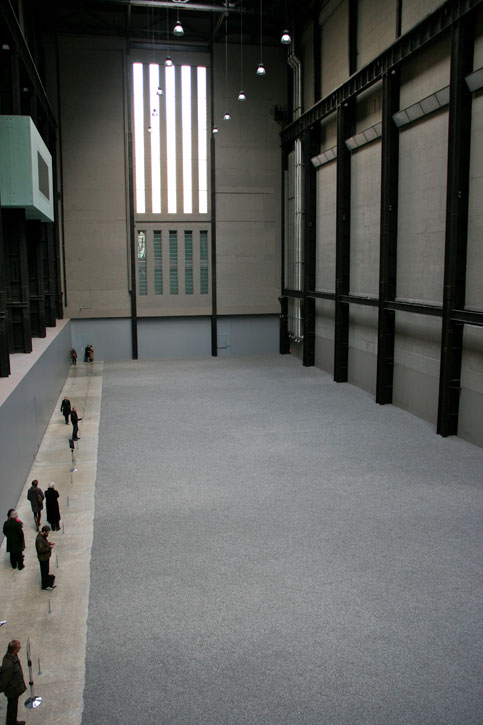
The vast range of objects he has engaged in his practice over the past three decades includes anything from sunflower seeds (materialised as a vast installation in porcelain at Tate Modern, 2010) and ancient pots (like those overwritten with the Coca Cola slogan), to the material legacy of lives devastated in tragedies such as the thousands of schoolbags retrieved from the debris of the earthquake and the lifeboats and lifejackets of migrants crossing waters whose fragile lives at the hand of wars are captured in his epic film Human Flow (2017).
Han Dynasty Urn with Coca Cola Logo
2014, sculpture by Ai Weiwei (b.1957) 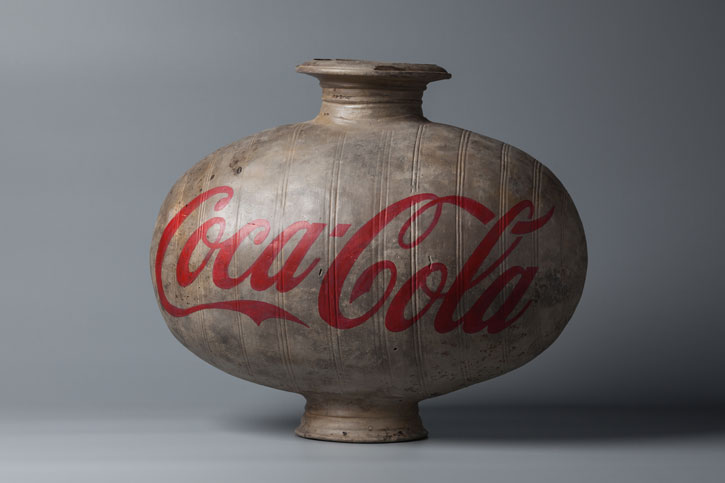
As a writer, filmmaker, blogger, activist, Ai's work as an artist reaches across disciplines and cultural divides, so most exhibitions offer just a small glimpse of his vast output. Since 2015, he has been living abroad in Germany, Britain and Portugal, but deep down his heart belongs to China, where his 90-year-old mother admonishes him never to return.
Dr Katie Hill, Program Director, MA Modern and Contemporary Asian Art at Sotheby's Institute of Art, London
'Ai Weiwei: The Liberty of Doubt' is on at Kettle's Yard, Cambridge until 19th June 2022

